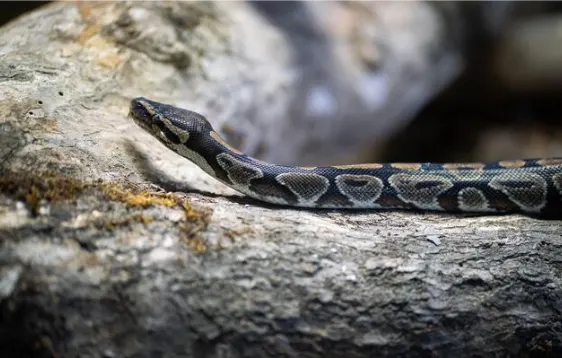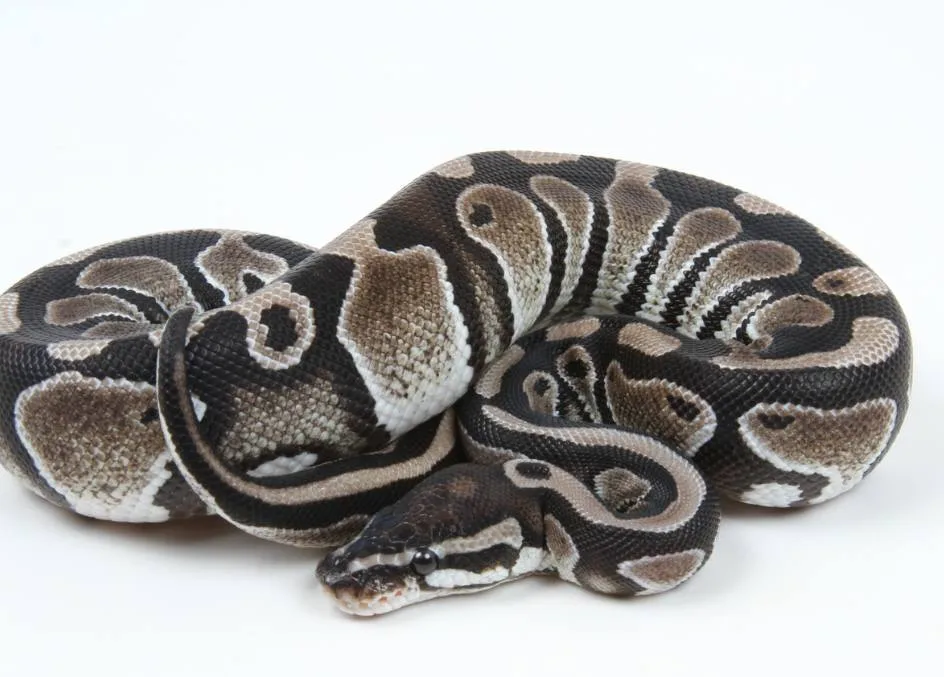Axanthic ball pythons are a unique and fascinating morph of the popular ball python species, Python regius. Known for their lack of yellow pigment, these snakes exhibit a striking coloration of grey, silver, white, brown, and black. This guide delves into the intricacies of axanthic ball pythons, covering their origins, physical characteristics, behavior, and more.
Since the early 1990s, selective breeding has produced over 4,000 ball python morphs. The axanthic ball python, first reliably bred in 1997 by Vida Preciosa International (VPI), stands out due to its recessive genetic mutation, axanthism. This mutation prevents the production of yellow pigments, resulting in a monochromatic appearance that has captivated reptile enthusiasts.
Table of Contents
Axanthic Ball Python: Quick Facts
- Scientific Classification:
- Kingdom: Animalia
- Phylum: Chordata
- Class: Reptilia
- Order: Squamata
- Family: Pythonidae
- Genus: Python
- Species: Python regius
- Conservation Status: Near Threatened
- Location: Sub-Saharan Africa
- Habitat: Savanna, grassland
- Diet: Carnivore (primarily rodents)
- Lifespan: 20 – 30 years
- Length: 3 to 5 feet
- Venomous: No
- Temperament: Docile, curious, hardy

Physical Characteristics
Axanthic ball pythons are easily identifiable by their lack of yellow pigment. Their coloration ranges from grey and silver to white, brown, and black. They often display reduced patterning compared to wild-type ball pythons. Typically, these snakes measure between 4 to 6 feet in length upon reaching adulthood and possess a bulky body with a slightly elongated, triangular head.
Habitat and Distribution
Native to Sub-Saharan Africa, ball pythons are commonly found in grasslands and savannas, though they can also inhabit forested areas. While axanthic ball pythons can occur naturally in the wild, they are extremely rare. The axanthic morph was first developed in captivity in 1997 by VPI, and most axanthic ball pythons today descend from this original line.
Behavior and Temperament
Ball pythons, including the axanthic morph, are known for their docile and curious nature. They are solitary animals, primarily nocturnal, and have a low aggression level. When threatened, they tend to curl up into a ball rather than bite, a behavior that gives them their common name.
Breeding and Lifespan
Axanthic ball pythons are prolific breeders in captivity. A typical clutch consists of 5 to 10 eggs, and the hatchlings are usually more greyish in color. As they age, their coloration may become slightly browner. With proper care, axanthic ball pythons can live between 20 to 30 years.
Identifying an Axanthic Ball Python
Axanthic ball pythons can be distinguished from other morphs and wild-type ball pythons by their lack of yellow pigmentation. Key identifying features include:
- Monochromatic coloration: grey, white, silver, black, and brown
- Reduced patterning compared to wild-type ball pythons
- More prominent brown coloration as they age
Conservation Status
According to the IUCN Red List, the ball python is classified as Near Threatened. This status indicates that while the species is not currently endangered, it could become so in the future. The exact population of axanthic ball pythons in the wild and in captivity is unknown.
Axanthic Ball Pythons as Pets
Axanthic ball pythons are popular pets due to their unique appearance and easy care requirements. They are readily available from reptile breeders and typically cost between $200 to $400. Combination morphs, such as axanthic pinstripe or axanthic pastel, are more expensive due to their rarity and the complexity of breeding them.
Care Requirements
Axanthic ball pythons, like all ball pythons, require a suitable habitat that mimics their natural environment. This includes:
- A secure enclosure with proper ventilation
- A temperature gradient ranging from 75-80°F on the cool side to 88-92°F on the warm side
- Humidity levels between 50-60%
- Hides and climbing structures to provide enrichment
- A diet consisting primarily of rodents, such as mice and rats
Regular handling can help maintain their docile nature, but care should be taken to avoid stressing the snake.
Health and Safety
Ball pythons are generally hardy snakes, but they can be prone to certain health issues, such as respiratory infections and mites. Regular veterinary check-ups and proper husbandry practices can help prevent these problems.
Despite their non-venomous nature, it is essential to handle them correctly to avoid stress and potential bites. If bitten, clean the wound with warm water and soap, and apply a bandage to prevent infection.
Q&A: Frequently Asked Questions About Axanthic Ball Pythons
Are axanthic ball pythons venomous?
No, axanthic ball pythons, like all ball pythons, are non-venomous. They kill their prey through constriction, using their strong bodies to suffocate their prey rather than using venom.
How do axanthic ball pythons hunt?
Axanthic ball pythons are ambush predators. They lie in wait, camouflaged in their environment, until a prey animal comes close enough. They then strike quickly, grabbing the prey with their backward-curving teeth and coiling around it to constrict and suffocate it before swallowing it whole.
Are axanthic ball pythons aggressive?
No, axanthic ball pythons are known for their docile nature. When threatened, they tend to curl into a ball rather than bite. They generally only bite defensively if they feel they cannot escape.
Where do axanthic ball pythons live?
In the wild, ball pythons are native to Sub-Saharan Africa. They inhabit grasslands, savannas, and sometimes forested areas. In captivity, axanthic ball pythons are bred by reptile breeders around the world.
What do axanthic ball pythons eat?
In the wild, ball pythons primarily eat small mammals like rodents and occasionally small birds. In captivity, they are typically fed captive-bred rats and mice.
How much do axanthic ball pythons cost?
Axanthic ball pythons generally cost between $200 and $400. Combination morphs that include the axanthic trait can be more expensive due to their rarity and the complexity of breeding them.

Are axanthic ball pythons rare?
Axanthic ball pythons are common in the exotic pet trade but extremely rare in the wild. The first axanthic ball python was bred in captivity in 1997, and most of the ones seen today are descendants of that original line.
How long do axanthic ball pythons live?
With proper care, axanthic ball pythons can live between 20 to 30 years in captivity.
Axanthic ball pythons are a fascinating and visually striking morph of the ball python species. Their unique coloration, combined with their docile temperament and easy care requirements, make them a popular choice for reptile enthusiasts.
By understanding their origins, physical characteristics, behavior, and care needs, you can provide a suitable environment for your axanthic ball python to thrive. As with all pets, responsible ownership and a commitment to their well-being are essential to ensure a long and healthy life for these beautiful reptiles.
- Enchi Ball Python: A Unique and Stunning Morph of Python regius - March 27, 2025
- Emerald Tree Monitor: The Enigmatic Green Guardian of the Rainforest - March 26, 2025
- The Egyptian Cobra (Naja haje): A Fascinating Serpent - March 25, 2025
